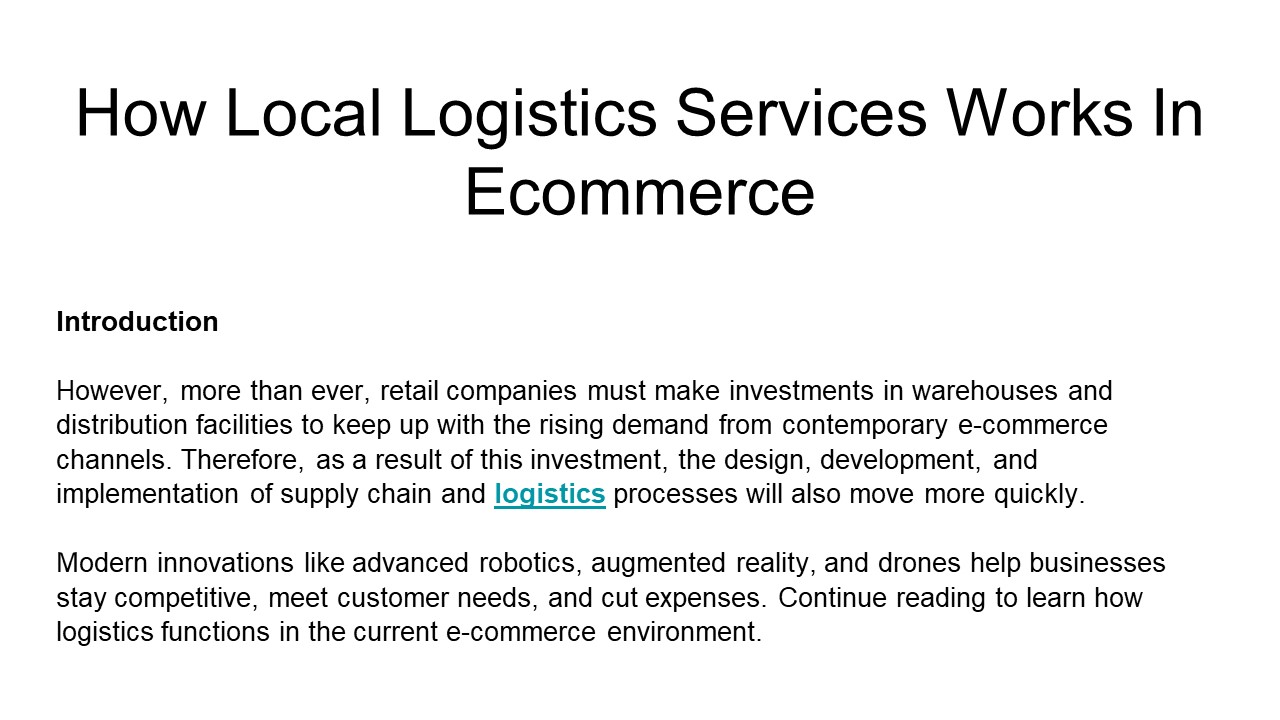How Local Logistics Services Works In Ecommerce PowerPoint PPT Presentation
Title: How Local Logistics Services Works In Ecommerce
1
How Local Logistics Services Works In Ecommerce
- Introduction
- However, more than ever, retail companies must
make investments in warehouses and distribution
facilities to keep up with the rising demand from
contemporary e-commerce channels. Therefore, as a
result of this investment, the design,
development, and implementation of supply chain
and logistics processes will also move more
quickly. - Modern innovations like advanced robotics,
augmented reality, and drones help businesses
stay competitive, meet customer needs, and cut
expenses. Continue reading to learn how logistics
functions in the current e-commerce environment.
2
Top Things To Consider For Ecommerce Logistics
- Visibility
- With the increase in the logistical requirements
of your business, it's crucial to hold onto your
vision. The majority of e-commerce platforms that
encounter fast growth think about increasing
their logistical capacity to handle the rise in
new orders or product shipments. - Expand your operations to use multiple drop
shippers and warehouses as your firm grows. - Make sure that things are still visible when
customers proceed to the checkout stage as you
expand to keep up with the growth. To meet these
demands, have enough stock on hand. - It is wise to collaborate with independent
logistics service providers and request their
assistance in creating the operational discipline
and procedures necessary for inventory management.
3
Demand planning
- Based on past data, successful internet retailers
forecast their inventories. They may easily
determine the quantity of inventory required by
their stores using this data and a few methods. - Social media promotion and website traffic
analysis are a couple of methods for putting
demand planning into practice. To ascertain the
kinds of things that consumers are likely to
purchase, keep an eye on seasonal trends like
holiday and weather-driven purchasing.
4
Last mile delivery
- According to research, last-mile services account
for up to 28 of total shipping expenses. The
last mile usually refers to the stage of delivery
before reaching a customer. - The last mile may be facilitated by your online
store. You can employ an LTL carrier to make the
service available if you own a B2B store. - Consumers consider the delivery experience when
rating your business. Make sure your last-mile
approach is resilient enough to meet consumer
expectations and strike a balance between
resource and cost demands.
5
Decentralized warehousing
- By employing this method, you can cut shipping
costs and delivery times by bringing products
closer to your clients. Utilize it to reduce the
final mile and guarantee that customers are happy
with your purchase fulfillment services. - To make this service more accessible, you could
convert retail locations into shipping hubs.
6
Managing relationships with 3PL
- E-commerce shippers wishing to outsource all or a
portion of their logistical tasks to other
companies may find third-party logistics
connections useful. Utilizing a 3PL enables you
to manage inbound shipments, store and track
inventory, and handle all fulfillment-related
tasks. - Your online business can concentrate on other
important tasks by using a 3PL while still
receiving effective shipping and order
fulfillment services.
7
Managing returns
- Even though managing your company's returns can
be difficult, it's best to keep them apart from
the supply chain of the products you're
anticipating moving forward. Returns may be
processed as reverse purchases when done
correctly. - According to research, online sellers can earn
returns of 24 to 36. To reach these numbers, you
must set up a number of procedures. - You can assign your team the responsibility of
managing returns or creating mini-warehouse
locations to provide affordable workspaces for
the task.
8
Final Thoughts
- With the popularity of delivery services and
online stores rising, the e-commerce logistics
industry continues to expand. It also keeps
coming up against new obstacles, thus online
retailers need to improve their logistics
performance. - Partnering with a reliable local logistics
services company can help you streamline your
eCommerce logistics processes.
9
Thank You
- For paying attentionFor more Details Please
visit our website Powerhouselv.com

